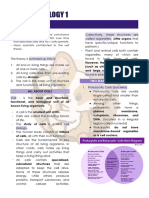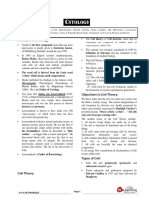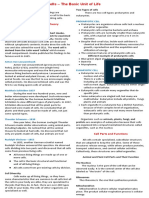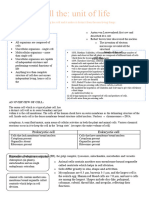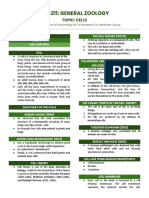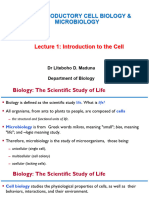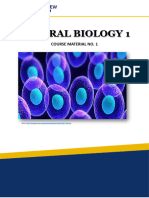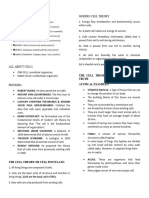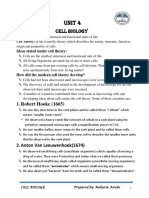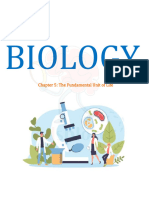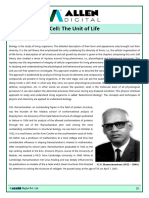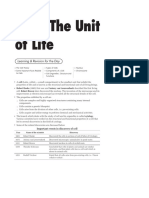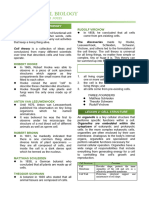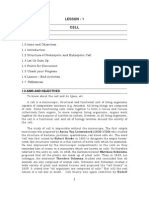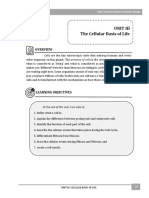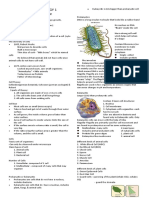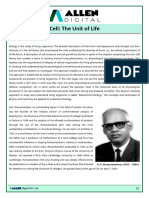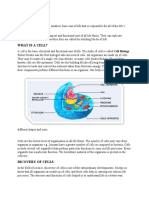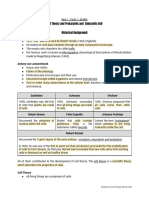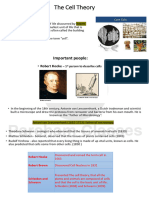3.1 Reinforcement: Key Concept
3.1 Reinforcement: Key Concept
Uploaded by
Eyad TalaatCopyright:
Available Formats
3.1 Reinforcement: Key Concept
3.1 Reinforcement: Key Concept
Uploaded by
Eyad TalaatOriginal Title
Copyright
Available Formats
Share this document
Did you find this document useful?
Is this content inappropriate?
Copyright:
Available Formats
3.1 Reinforcement: Key Concept
3.1 Reinforcement: Key Concept
Uploaded by
Eyad TalaatCopyright:
Available Formats
SECTION CELL THEORY
3.1 Reinforcement
Cell Structure and Function
KEY CONCEPT Cells are the basic unit of life.
CHAPTER 3
The invention of the microscope in the late 1500s revealed to early scientists a whole
new world of tiny cells. Most cells are so small that they cannot be seen without a
microscope. The discoveries of scientists from the 1600s through the 1800s led to the
cell theory, which is a unifying concept of biology. The cell theory has three major
principles:
• All organisms are made of cells.
• All existing cells are produced by other living cells.
• The cell is the most basic unit of life.
All cells can be divided into two major groups: prokaryotic cells or eukaryotic cells.
The main differences between the two kinds of cells are in their structure:
• Eukaryotic cells have a nucleus defined by a membrane, while prokaryotic cells
have no nucleus.
• In eukaryotic cells, the DNA, or genetic information, is found in the nucleus. In
prokaryotic cells, the DNA is found in the cytoplasm, the jellylike substance
that fills both types of cells.
• Eukaryotic cells have organelles, structures that perform jobs for a cell. Most
organelles are surrounded by membranes. Prokaryotic cells do not have organelles
surrounded by membranes.
Prokaryotic cells make up organisms called prokaryotes. All prokaryotes are tiny
Copyright by McDougal Littell, a division of Houghton Mifflin Company
and consist of single cells. Bacteria are prokaryotic cells. Eukaryotic cells make
up eukaryotes. You are a eukaryote, as are plants and some types of single-celled
organisms. All multicellular organisms, or organisms that have many cells, are
eukaryotes.
1. What is the smallest, most basic unit of life?
2. Where is the DNA in a prokaryote? in a eukaryote?
3. Why would you need a microscope to see a prokaryotic organism?
4. A friend tells you he read somewhere that rotting garbage can turn into maggots, which
are fly larvae, and the maggots then can grow into adult flies. What part of the cell
theory could you use to refute his claim?
4 Reinforcement Unit 2 Resource Book
McDougal Littell Biology
You might also like
- 8085 Time-Delay-And-CounterDocument6 pages8085 Time-Delay-And-CounterM jhansi100% (1)
- Loan Policy Document 2019-20 Part-A PDFDocument176 pagesLoan Policy Document 2019-20 Part-A PDFSamiran DebnathNo ratings yet
- Cell Theory: Teacher Notes and AnswersDocument3 pagesCell Theory: Teacher Notes and AnswersRainNo ratings yet
- Cell Theory ACtivityDocument2 pagesCell Theory ACtivityMa.Janice Garcia0% (1)
- Cell TheoryDocument4 pagesCell TheoryemNo ratings yet
- Ytology: History of Cell BiologyDocument39 pagesYtology: History of Cell BiologyMonika PatidarNo ratings yet
- Day 20 Main Concepts of Life Sciences: CelleDocument4 pagesDay 20 Main Concepts of Life Sciences: Cellekarthikeyanbose98No ratings yet
- The fundamental unit of life (Lakshmeer)Document4 pagesThe fundamental unit of life (Lakshmeer)aviiNo ratings yet
- Science & TechnologyDocument115 pagesScience & TechnologyvinayNo ratings yet
- gen bio module 2 (1)Document3 pagesgen bio module 2 (1)megannsyy928No ratings yet
- Science Reviewer MidtermDocument11 pagesScience Reviewer MidtermGenna CuencaNo ratings yet
- Synchronous - Cell Theory - September 9Document30 pagesSynchronous - Cell Theory - September 9Danielle Nicholle PatricioNo ratings yet
- Biology Cell Notes FinalDocument2 pagesBiology Cell Notes FinalDark hunter Gaming zoneNo ratings yet
- Unit 4 CELL BIO - 2023 - 230215 - 182618Document15 pagesUnit 4 CELL BIO - 2023 - 230215 - 182618SB silentNo ratings yet
- NCS211 CellsDocument4 pagesNCS211 CellsOrtiz, Jazmyn Q.No ratings yet
- The Cell TheoryDocument6 pagesThe Cell TheoryJefrelyn Eugenio MontibonNo ratings yet
- DFGHJKLDocument25 pagesDFGHJKLmeowmeow2224No ratings yet
- Lecture 1-Introduction To The CellDocument18 pagesLecture 1-Introduction To The CellThuto SmithNo ratings yet
- SSGBIO1 - CM Week 1Document16 pagesSSGBIO1 - CM Week 1sgdick31No ratings yet
- تخدير المحاضرة الاولىDocument7 pagesتخدير المحاضرة الاولىXcv FfgNo ratings yet
- Bio 101 PartDocument17 pagesBio 101 Partgodzis05No ratings yet
- Chapter 5 the Fundamental Unit of LifeDocument29 pagesChapter 5 the Fundamental Unit of LifeSrinibash JenaNo ratings yet
- Gen Bio ReviewerDocument4 pagesGen Bio ReviewerDoreen Shane CabigonNo ratings yet
- Cell, Theory, Structure & FucntionDocument43 pagesCell, Theory, Structure & FucntionJames Paul VelascoNo ratings yet
- Cell the Unit of LifeDocument26 pagesCell the Unit of LifevetvadivuNo ratings yet
- Cells and StructureDocument17 pagesCells and StructurekayleenerikaNo ratings yet
- Spgbio NotesDocument22 pagesSpgbio NotesKaycee HeokkaidoNo ratings yet
- Chapter - 5 The Fundamental Unit of LifeDocument16 pagesChapter - 5 The Fundamental Unit of Lifekarunadawar.11No ratings yet
- Unit 4 CELL BIO - 2014 FinalDocument17 pagesUnit 4 CELL BIO - 2014 FinalTizita EmanaNo ratings yet
- Watermarked - Chapter 5 The Fundamental Unit of LifeDocument29 pagesWatermarked - Chapter 5 The Fundamental Unit of Lifedhairyamangal99No ratings yet
- Cell - The Unit of LifeDocument29 pagesCell - The Unit of Lifepalsuvra95No ratings yet
- Rankers Cell Unit of LifeDocument15 pagesRankers Cell Unit of Lifevisheshgupta756No ratings yet
- Intro2 - Different Types of CellsDocument22 pagesIntro2 - Different Types of CellsCheryl MountainclearNo ratings yet
- L1-cell-propertiesDocument22 pagesL1-cell-propertiesPoowadon RattanasreethongNo ratings yet
- GENBIOdocxDocument8 pagesGENBIOdocxjanezpersonalzNo ratings yet
- Fundamentals of Biological SystemDocument131 pagesFundamentals of Biological Systempon_parivendanNo ratings yet
- Gen Bio 1 Lesson 1234 1Document5 pagesGen Bio 1 Lesson 1234 1wattpadjl97No ratings yet
- 11th Class Notes 2024 Bio Subjective CH No 4Document22 pages11th Class Notes 2024 Bio Subjective CH No 4tahayasirytofficialNo ratings yet
- EED 5 Unit 3Document23 pagesEED 5 Unit 3Lara Mariz FragataNo ratings yet
- CELLSDocument13 pagesCELLSTrisha MabaleNo ratings yet
- General Biology Cells1Document6 pagesGeneral Biology Cells1Kristine CarvajalNo ratings yet
- MST chapter 4 for midtermDocument4 pagesMST chapter 4 for midtermAbdul macaampaoNo ratings yet
- Cell Biology (Fatima)Document12 pagesCell Biology (Fatima)zahrabakry.zf2001No ratings yet
- Cell - The Unit of LifeDocument29 pagesCell - The Unit of Lifep11925885No ratings yet
- Cell DefinationDocument6 pagesCell DefinationaliNo ratings yet
- CELLDocument17 pagesCELLsiddharthpandey4apr2009No ratings yet
- Cell Theory and Prokaryotic and Eukaryotic CellDocument4 pagesCell Theory and Prokaryotic and Eukaryotic Cellmj espanolaNo ratings yet
- Chapter 1b - CellDocument49 pagesChapter 1b - CellKw ChanNo ratings yet
- Year 6 Week 3 Pro and EukaryoyesDocument18 pagesYear 6 Week 3 Pro and EukaryoyesShreya MaheshwariNo ratings yet
- Biology 1Document35 pagesBiology 1alkadafeNo ratings yet
- Lecture-1-Cell and Cell TheroryDocument13 pagesLecture-1-Cell and Cell Therorytirion7894No ratings yet
- 0 BooksDocument35 pages0 Bookshamzakamboh0987No ratings yet
- Cell BiologyDocument71 pagesCell BiologyShakyra Lei PaballaNo ratings yet
- Cell TheoryDocument5 pagesCell TheoryAdit KumarNo ratings yet
- Types of Cell PDFDocument20 pagesTypes of Cell PDFDave Billona100% (1)
- Wa0000.Document53 pagesWa0000.Bunny SuvvariNo ratings yet
- LESSON 3 - Prokaryotid Vs Eukaryotic CellsDocument41 pagesLESSON 3 - Prokaryotid Vs Eukaryotic CellsHyacinth RaeNo ratings yet
- GEN-BIO-LESSON-1_-INTRODUCTIONDocument3 pagesGEN-BIO-LESSON-1_-INTRODUCTIONflores136469140130No ratings yet
- BCH Industrial BiochemistryDocument18 pagesBCH Industrial BiochemistrySherifdeen JibrinNo ratings yet
- 2022.08.24 Cells PT 1 (Ch1)Document37 pages2022.08.24 Cells PT 1 (Ch1)Allison KwanNo ratings yet
- The Animal Cell and Division Biology for Kids | Children's Biology BooksFrom EverandThe Animal Cell and Division Biology for Kids | Children's Biology BooksNo ratings yet
- The Cell and Division Biology for Kids | Children's Biology BooksFrom EverandThe Cell and Division Biology for Kids | Children's Biology BooksNo ratings yet
- High School DXD Volume 16 - Daywalker of The Extracurricular LessonDocument124 pagesHigh School DXD Volume 16 - Daywalker of The Extracurricular LessonArushamNo ratings yet
- Mid1 Question BankDocument3 pagesMid1 Question Bankarjunkarna2898No ratings yet
- Daily Report: Various Pressure Vessel (Baru Gas Plant Project - Pltgu Tenayan) Daily PhotographDocument1 pageDaily Report: Various Pressure Vessel (Baru Gas Plant Project - Pltgu Tenayan) Daily PhotographRicardo NapitupuluNo ratings yet
- Form 66Document2 pagesForm 66skgupta2711No ratings yet
- V Max Air Disinfection MKTFM 257 Rev B WebDocument2 pagesV Max Air Disinfection MKTFM 257 Rev B WebSergio GarciaNo ratings yet
- Lonely Planet West-Africa-CameroonDocument30 pagesLonely Planet West-Africa-Cameroon文者美善治者理No ratings yet
- Transformation of FunctionsDocument16 pagesTransformation of Functions12110-083No ratings yet
- Non Charitable Purpose Trust.Document75 pagesNon Charitable Purpose Trust.C LMNo ratings yet
- 1 s2.0 S0020768307001837 MainDocument24 pages1 s2.0 S0020768307001837 MainGregory HopkinsNo ratings yet
- Organization of DataDocument5 pagesOrganization of Datamayankharbansi35No ratings yet
- Gree LSQWRFDocument20 pagesGree LSQWRFMiroslav LuladžićNo ratings yet
- 273Document75 pages273LabroufiAbdelouahedNo ratings yet
- Geekie One - EF - Mistas - Inglês 6º Ano Level 1 - Cap. 03 - Friendship - Verb To Be and Identifying PeopleDocument36 pagesGeekie One - EF - Mistas - Inglês 6º Ano Level 1 - Cap. 03 - Friendship - Verb To Be and Identifying PeoplePriscila CasariNo ratings yet
- Sap Basis Introductory Training Program Day8Document50 pagesSap Basis Introductory Training Program Day8prihastonoNo ratings yet
- SAP Workflow For DummiesDocument13 pagesSAP Workflow For DummiesKautsar Al FarabiNo ratings yet
- AMTE 231 - 12B - DOCUMENT SUMMARY MASTER SUMMARYDocument1 pageAMTE 231 - 12B - DOCUMENT SUMMARY MASTER SUMMARYcferrer567No ratings yet
- Review of Special RelativityDocument13 pagesReview of Special RelativitySeaton HarnsNo ratings yet
- Java - Unit-5Document50 pagesJava - Unit-5Gopi TirumalaNo ratings yet
- Emergency Radiology Urinary Tract - 240227 - 073849Document126 pagesEmergency Radiology Urinary Tract - 240227 - 073849dr.tonichenNo ratings yet
- prim2 Revision math 1st term2025Document12 pagesprim2 Revision math 1st term2025moo22990No ratings yet
- (Yoon,: CommunicationsDocument3 pages(Yoon,: CommunicationsCao Thị Vân GiangNo ratings yet
- Practice Problem Set 5 With AnswersDocument7 pagesPractice Problem Set 5 With AnswersJoy colabNo ratings yet
- 20191217202959BN123581604Document2 pages20191217202959BN123581604Alfakhri RizqullohNo ratings yet
- CS 303e, Assignment #10: Practice Reading and Fixing Code Due: Sunday, April 14, 2019 Points: 20Document2 pagesCS 303e, Assignment #10: Practice Reading and Fixing Code Due: Sunday, April 14, 2019 Points: 20Anonymous pZ2FXUycNo ratings yet
- Supply Chain Diversity Equity Inclusion AscmDocument9 pagesSupply Chain Diversity Equity Inclusion AscmDennis DuNo ratings yet
- Patriot Consola SupDocument1 pagePatriot Consola SupKristofer OyervidesNo ratings yet
- Dieci - 2022 Ten Course Autumn Tasting Menu - ENDocument1 pageDieci - 2022 Ten Course Autumn Tasting Menu - ENPawlin PawloffNo ratings yet
- My Lilly-2Document981 pagesMy Lilly-2Thandolwethu Mbatha100% (2)




